Travels with Grace: Florida, 1925
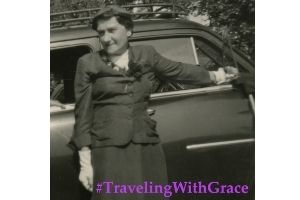
Welcome to the next segment of our 2019 #TravelTuesday series: Travels with Grace, where we’re sharing (and annotating) posts from the travel diaries of Grace Amelia Hecht, native Baltimorean, b. 1897 and d. 1955. This week we head to Florida.
As mentioned in my introductory post, transcription errors sometimes occur and I’ve made my best guesses where possible, denoted by [brackets]. This segment is where we also encounter our first real instances of some uncomfortable, problematic language – Grace is traveling in the southern parts of the United States and while her vocabulary is mild, it is certainly not what we would consider progressive. – Rachel Kassman, marketing manager
En Route to Jacksonville
March 2, 1925: Bertha went with us to the station and the train left at 1:20p.m. We had a glimpse of Washington and Richmond passing thru. The country looks bare and dismal. Nothing eventful so far.
March 3, 1925: At nine o’clock this morning while we were eating breakfast the tender jumped the track and we didn’t budge until 2 p.m. Luckily, we were well supplied with reading matter and I had my crossword puzzles. This afternoon we rode through Georgia, a marshy swampy country apparently only peopled by negroes who live in very dilapidated habitations with underfed cows and scrubby pigs. It is a most uninteresting landscape. We arrived in Jacksonville at 5:30p.m. 5 hours late, which by the way boasts a fine station, and were recommended to the Hotel Windham, unpretentious but comfortable. We were most surprised at the coolness of the temperature about 60 degrees but dry and feeling colder than this would indicate.
Jacksonville
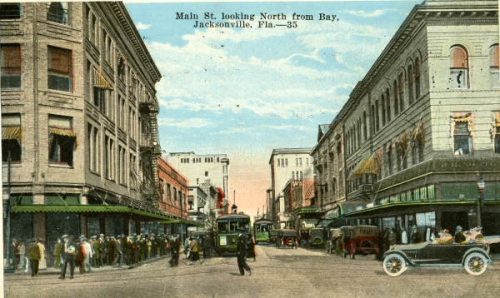
March 4, 1925: This morning we took a ride thru Jacksonville, which does not impress us very favorably. There are a number of factories which make it rather dirty and altho there are some handsome homes there are more which look neglected. The negros, who comprise a good half of the population live in miserable shanties. There is a great deal of traffic for a town of this size (110,000) a number of hotels at least 1 fine department store ([Colian’s?]). There are many palms and camphor trees along their streets. In the park we saw some ancient alligators with moss growing on their backs. Before lunch I sunned myself on a bench in front of the city hall. Laziness [pervaded?] in the air. At 4:30 p.m. we took the bus for St. Augustine arriving there at the Bennett House just before dark. The ride was uninteresting, nothing but [?] also palms and palmettos, and [?] with Spanish moss. It seems weird to me and clings to telegraph poles and [?] wires. Were entertained by a jolly negro troop at the hotel tonight.
Consisting of a perfectly trained sextet of girls singing jubilee and folk songs with an accom[panying] pianist at the piano and another girl giving dialect reading. All so clear and intelligent looking. They come with Prof. Collier, a negro educator who conducts the only colored high school in Fla. near here and he takes them around the country making pleas for the school which is maintained entirely on private contributions as the state does practically nothing for the higher education of the negro and very little even for the Elementary which accounts no doubt for their miserable condition. This Prof. Collier is a wonderful man doing a very fine work for his people.
St. Augustine
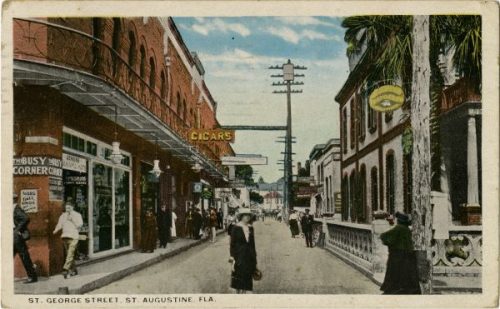
March 5, 1925: Took a horse-drawn phaeton this morning with a funny negro driver who showed us most of St. Augustine an a couple of hours. We loved it. The houses are small, Spanish and the gardens very pretty with their ferns, bamboo trees, hibiscus, palms, cacti, bogainvillia, and other flowers and trees. They are just a bit wild and uncultivated looking which rather adds than distracts from their charm.
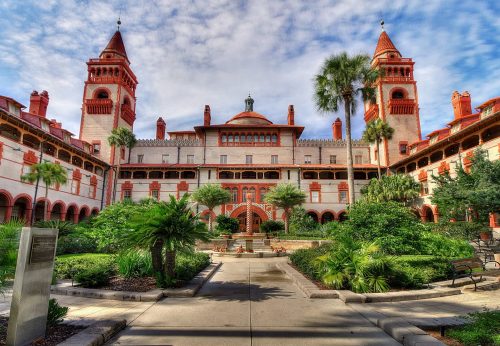
We saw the two finest hotels, Ponce de Lion and Alcazar, the old slave market, the Flagler’s Memorial Church, old Huguenot cemetery, old city wall and gates, oldest house in the country (muchly restored I imagine), rode thru an avenue of magnificent live oaks, into an orange grove (Garret Grove) where we ate some of the fruit and met a delightful little French woman [(agarde-malade, from Bordeaux)] with whom we talked. Drank water from the so-called fountain of youth, sulphur water, discovered by Ponce de Lion and heard a [talk?] on same. Heard the Highlander’s band in the square this afternoon. The air is simply marvelous and really invigorating here. I walked quite a distance. Tonight, a ladies orchestra played at hotel.
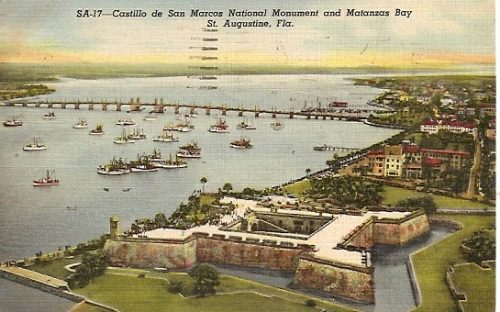
March 6, 1925: Sunned on the porch this morning which faces the old Spanish Fort Marion and Mananzas [Matanzas] Bay. Talked with some of the guests who are very friendly. At 4:00 P.M. we took the motor bus for Daytona on a ride of 2 and a half hours over the Dixie Highway, a fine brick road passing thru Hastings and Bunnal[?]. Acres and acres of potato fields are passed. The road is overhung by arching trees laden with the ever-present moss which is used for upholstering when dried and is also relished by the cattle which, however, look exceeding undernourished. Crossed the picturesque Tomoka river and on thru the new and handsome development of Rio Vista besides the Holifax which is making rapid progress. Houses mostly stucco in the Spanish style. We arrived at the Arroyo Gardens Hotel at 6:30 in time for dinner. Have a suite of 3 bedrooms, bath, hall sitting room and pantry all elegantly furnished. The hotel is in the Spanish-Moorish style surrounded by beautiful gardens and from the long narrow arched porches and turreted roof is had a magnificent view of river and ocean beyond.
Daytona
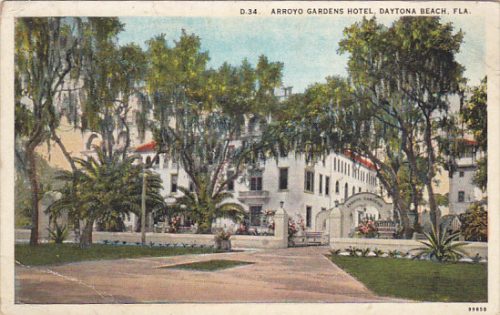
March 7, 1925: Today we sat in the beautiful Arroyo Gardens and I talked with the beautiful young Spanish girl who is the daughter of the proprietor. In the gardens are stately palms, palmettos, poinsettia, bamboo, peppers, campliors[?], rubber trees, roses, oleanders and many other flowers, orange and grapefruit trees and some little yellow plums, the latter heavy with fruit which the guests are welcome to pick. Adjacent is the orange grove in which the trees are tagged to correspond with the numbers of the rooms so that the guest has his own tree for the duration of his visit. There are pretty benches and rustic arbors in which to loll, a swimming pool and little mah jong house. The dining room is separated from the hotel by an open patio in which a fountain plays amid floral setting. We took a walk up Ridgewood Ave the principal residential street of Daytona lined with charming cottages, and took our dinner at the Ridgewood Hotel.
Daytona and Ormond
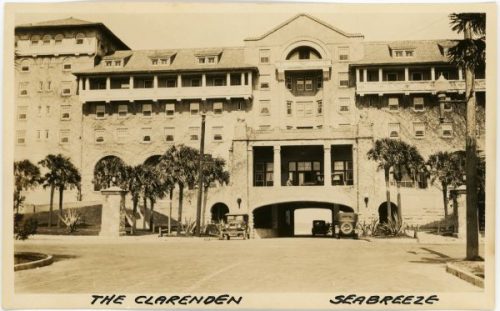
March 8, 1925: We had a most interesting ride in sightseeing bus, driven by Mr. Abercrombie, a typical Southern gentleman, today covering all of Daytona, Ormond (on the river side), Daytona Beach, Ormond Beach (on the ocean side) where we rode for twenty-five miles within a few feet of the edge of the waves on the hardest beach in the world which is the straightaway track for autoraces). We saw the beautiful Clarendon and Ormond Beach Hotels (Haglers) and John D. Rockefeller’s house (John D. passed us in his car) and the golf links where he plays every morning. Many of the houses we passed are very original and artistic. One was painted in pastels shading from pink to blue. One row of houses is separated from the sidewalk by the river and one of the houses has a drawbridge held by chains reaching from the front steps to the street spanning the river which [?] simulates a moat. There are many lovely hotels everywhere. We visited the National Gardens where strawberry plants are grown in perforated cypress boxes piled [entire?] one above the other with onions and peppers on top and parsley in between. Also a variety of beautiful flowers and [trees?] are sold and transplanted elsewhere. It was a most enjoyable outing.
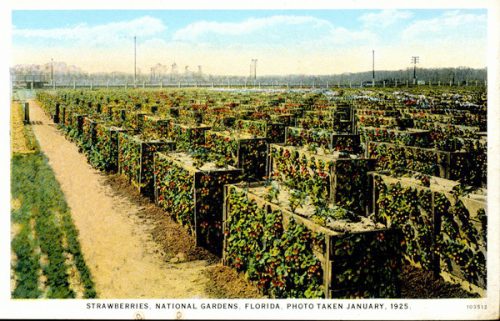
Daytona and Orlando
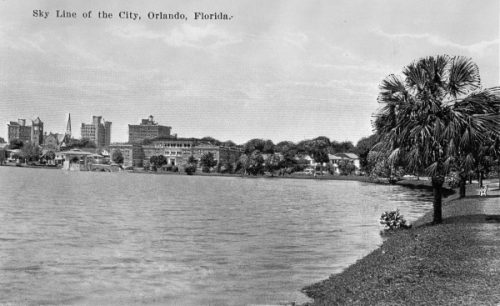
March 9, 1925: We left at 10 a.m. in a small car for Orlando. The road ran between swamps and marshlands for some distance and here we saw the colored people fishing from the side of the road. The thickness of the vegetation conceals the depth of the water which is said to be from 12 to 15 ft. deep and abounding in fish, turtles and crocodiles though we saw nothing but turkey buzzards, the scavengers of this region and the beautiful blue herons. We passed thru the clean and [wao?] cities of Sareford and DeLaud with their pretty [unreadable?], variegated stucco houses colored in the favored pastel shades and chiefly of Spanish design in the bungalow style, tho there are also colonial houses, and all boast delightful gardens. There are a number of truck farms in this vicinity, celery bring the main product.

There is a most inviting [hotel?] at Altamonte [Springs] and Winter Park, with its very luxurious hostelries each more romantic looking than the other, its country clubs, golf courses and chains of natural lakes is one of the loveliest resorts we have yet seen. This is the heart of the cities country and the air is heavy with the perfume of the blossoms. There are almost 144 lakes in the neighborhood of Orlando, Lakes Eola and Luzerne being the two principals. The pretty schools are an outstanding feature of this community and we saw the public park where old ladies and gentlemen were playing checkers, carts, and dominoes in a pavilion but are not allowed to gamble. We had brunch at the Aug Elilt[?] in the heart of the very up-to-date business section. Returned to Daytona at 7 p.m.
Thanks for reading “Traveling with Grace.” Join us next Tuesday for the second leg of Grace’s Florida trip!
